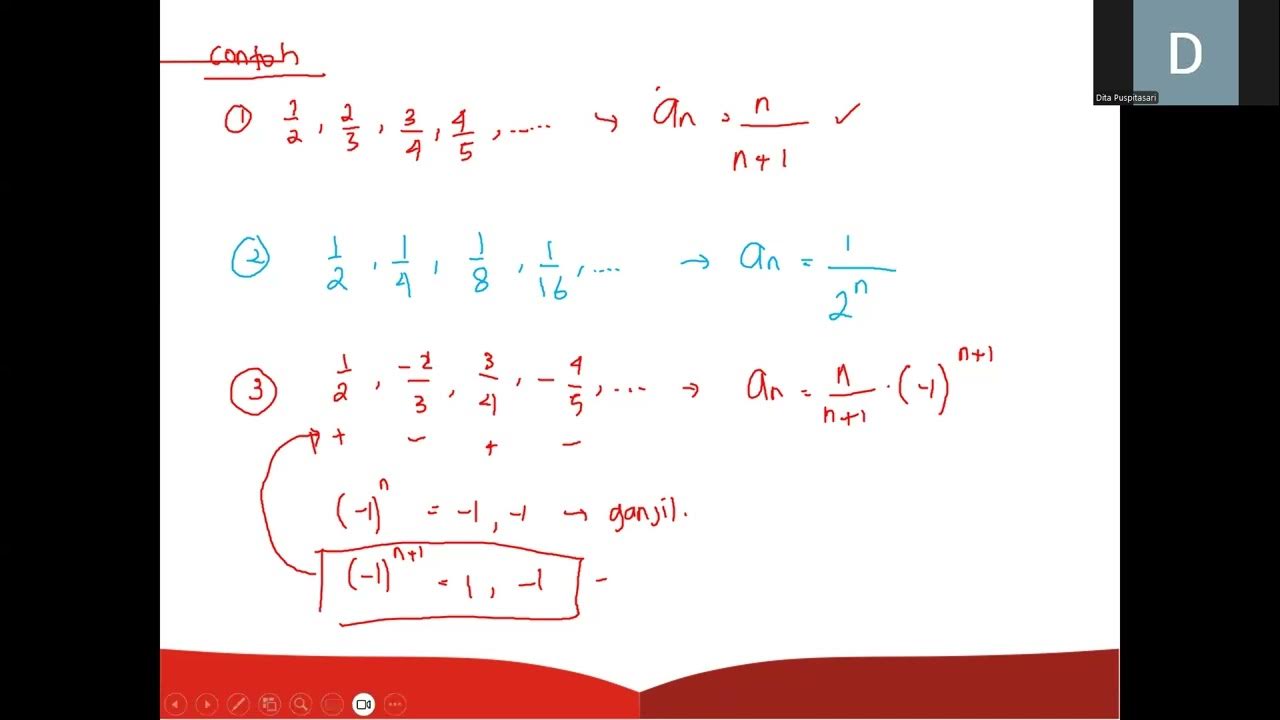Apa itu Ekor Barisan Bilangan Real?
Summary
TLDRIn this lecture on real analysis, the focus is on understanding the 'tails of sequences' (ekor barisan) and their convergence properties. The lecturer explains the concept of a sequence and its subsequences, specifically how the 'tail' of a sequence starts from a certain index and follows a specific pattern. Key theorems about convergence are introduced, including the idea that if a sequence converges, its tail also converges to the same limit. Several examples are provided, including sequences with alternating and constant terms, to demonstrate the application of these theorems in determining the convergence of sequences.
Takeaways
- 😀 The topic of the lecture is 'Tail Sequences' (Subsequences) in real analysis, specifically focusing on sequences of real numbers.
- 😀 A tail sequence is defined as a subsequence starting from a specific index (m+1) onward, taking every subsequent element.
- 😀 For example, the tail sequence starting from the 10th element of a sequence is formed by elements from the 11th onward.
- 😀 Tail sequences are important in understanding the convergence behavior of sequences in real analysis.
- 😀 The first key theorem in the lecture states that if a sequence converges, its tail sequences also converge to the same limit.
- 😀 Conversely, if a tail sequence converges, the original sequence also converges to the same limit.
- 😀 The second key theorem provides a method to prove convergence without directly applying the epsilon-delta definition of a limit.
- 😀 To apply the second theorem, a sequence must be bounded and the absolute difference between terms should be controlled by a constant multiplied by a small sequence.
- 😀 A specific example showed that if a sequence has tail sequences converging to a constant (like 5), then the entire sequence converges to that constant.
- 😀 The lecture also includes examples where sequences such as 1/(1 + 5n) converge to 0, demonstrating how tail sequences help in proving limits.
- 😀 At the end, several exercises and discussions are suggested for further understanding of tail sequences and their application in proving convergence of sequences.
Q & A
What is the concept of 'tail sequence' (ekor barisan) in real analysis?
-A 'tail sequence' refers to a subsequence of a given sequence of real numbers, starting from a specific index, often denoted as 'm', and consisting of the elements from the original sequence starting from that position onward.
How is a tail sequence defined mathematically?
-Given a sequence of real numbers X = {x_n}, a tail sequence starting from index 'm' is the sequence {x_(m+1), x_(m+2), x_(m+3), ...}, where 'm' is a positive integer and the sequence continues from the m-th element onward.
What is the significance of the tail sequence in relation to the convergence of a sequence?
-The tail sequence helps determine whether the original sequence converges. If the tail sequence converges to a limit, then the original sequence also converges to that same limit, as stated in the first theorem discussed.
What is the first theorem about tail sequences?
-The first theorem states that a sequence X converges if and only if the tail sequence starting from any index 'm' also converges. Moreover, the limit of the tail sequence will be the same as the limit of the original sequence.
Can you give an example of a tail sequence from the transcript?
-Yes, an example given in the transcript is for the sequence X = {1, 1/2, 1/3, 1/4, ...}. The tail sequence starting from the 10th element would be {1/11, 1/12, 1/13, ...}, and this sequence is convergent to 0.
What does the second theorem about tail sequences describe?
-The second theorem provides a method to determine the convergence of a sequence without directly using the epsilon definition. It involves finding a constant 'c' and an integer 'm' such that for all 'n' greater than 'm', the sequence's terms are bounded in a certain way, implying convergence.
What is the condition for a sequence to be convergent according to the second theorem?
-According to the second theorem, a sequence X converges to a limit 'x' if there exists a positive constant 'c' and an integer 'm' such that for all 'n' greater than 'm', the absolute difference between the nth term and the limit is less than 'c' times a decreasing sequence.
How is the sequence {1 + 5n} analyzed in the transcript?
-The sequence {1 + 5n} is analyzed by showing that it is bounded between two values and using the second theorem to conclude that its limit is 0, demonstrating its convergence.
What is the conclusion for the sequence {1 + 5n} as discussed in the lecture?
-The sequence {1 + 5n} is convergent, and its limit is 0, based on applying the second theorem and analyzing the relationship between the terms.
What is the general application of the tail sequence theorems in real analysis?
-Tail sequence theorems are often used to simplify the proof of convergence for complex sequences. Instead of directly calculating the limit using epsilon definitions, these theorems allow us to analyze the behavior of a sequence starting from a specific index, making it easier to determine if the sequence converges.
Outlines

This section is available to paid users only. Please upgrade to access this part.
Upgrade NowMindmap

This section is available to paid users only. Please upgrade to access this part.
Upgrade NowKeywords

This section is available to paid users only. Please upgrade to access this part.
Upgrade NowHighlights

This section is available to paid users only. Please upgrade to access this part.
Upgrade NowTranscripts

This section is available to paid users only. Please upgrade to access this part.
Upgrade Now5.0 / 5 (0 votes)





